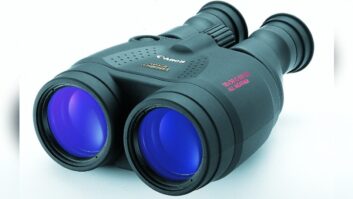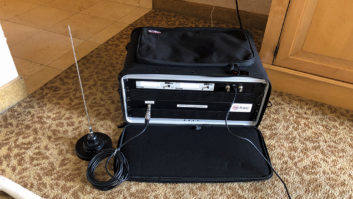(click thumbnail)Fig. 1: How many problems can you spot in this photo?Do you enjoy hidden word puzzles? They’re supposed to be great for exercising your brain. Well, here’s a spin on that concept, which we call the hidden problem picture.
Let’s say you showed up at the FM site in Fig. 1 as the new CE. Make a list of problems you can identify from the picture, and compare them to the list at the end of this column.
* * *
Reliability of today’s transmission equipment can cause a mentality of “out of sight, out of mind.” With so many spinning plates, you may only have time to worry about the ones that are about to crash.
But if all you can schedule is one hour a month at each site, do it!
What should you check?
Salisbury University Chief Engineer Bruce Blanchard grabs a spiral notebook for each site and starts writing. The notebook will eliminate the need to write on equipment panels and can provide you a history of inspections. Bruce adds that veteran engineers will remember FCC-required maintenance logs, which documented a variety of inspections at the station.
Start with your STL and record the operating parameters. If you’re fortunate enough to have the factory test data, compare that information to what you read, to form a baseline for normal operation. Signal strength and DC voltages may come in handy in the future; write them down. When a piece of equipment fails, you’ll be grateful to have a starting point to compare readings for quicker diagnosis and repair.
Make it a general rule to measure anything with a power supply. Power supply capacitors are under constant stress and their complete failure can ruin your day. Catastrophic failure is pretty easy to spot; but aging capacitors also can leak, allowing ripple on the DC power supply rails. This slow failure can be more insidious in its effect on equipment.
(click thumbnail)Fig. 2: Keep fans and filters clean, like this exciter.Has equipment been in service for more than seven years? It’s probably time to replace the power supply electrolytic capacitors. This proactive replacement may help you spot other problems.
A can of compressed air comes in handy to clean the dust off heat sinks while you’re inside. Clean heat sinks allow cooler operation. Outside, keep fans and filters clean, as seen in Fig. 2.
Check operation of audio processing, remote control equipment and monitors. While you’re performing this operational check, note the type of fuse. An adequate stock of spare fuses on hand is a lifesaver when your local electronics parts or RadioShack is closed.
Keep your “record of readings” notebook at each site and take the five or 10 minutes to record the operating parameters for each piece of equipment, including the transmitter. You’ll find this a great investment to help minimize future problems.
Thanks to Bruce Blanchard of WSCL(FM)/WSDL(FM) in Salisbury, Md.
* * *
OK let’s see how observant you are with Fig. 1.
The Queen Anne’s Lace is pretty but not welcome at a transmitter site. It appears the former engineer did the right thing by placing gravel around the building, but he or she let the weeds get out of hand. The gravel will deter rodents and snakes but when weeds grow, the growth offers cover to these varmints. Clear it out!
The growth has gotten out of hand inside the tower fence. The coax running up the tower identifies this as an FM tower so there are no buried radials; remove growth to include the roots and cover the space with landscape fabric or plastic to deter growth.
(click thumbnail)Fig. 3: Fasten tower grounds securely.Now that the area inside the tower is clear, check the tower grounding. Is it secure? Look for green corrosion, rust or loose connections. Grounds should be securely silver soldered or cadwelded, as seen in Fig. 3. Measure the edge of the fence to the tower. When you get back to the studio, check that the fencing meets ANSI specs.
There’s no tower identification number posted on the fence, nor is there an emergency contact sign. These are useful to identify the owner in case of an emergency, and in the case of the FAA Tower Registration Number, its omission may put you in violation. Tower identification signs can be placed at the tower, as shown in Fig. 4, or at entry to the site, as in Fig. 5.
(click thumbnail)Fig. 4: A properly identified tower. Note both the ID number and a Rad-haz sign.
One source for tower signs is Antenna ID Products of Glenmoore, Pa., www.antennaid.com. In addition to a variety of signs, they also provide guy wire markers and balls.
The barbed wire at our site is intact (a good thing), but the wooden box is a ready-made “ladder” for vandals. Not only does it provide access to inside the tower fence, it’s a great home for undesirable animals and insects. The box could also be moved to the side of the building, offering access to the roof or ventilation opening. Eliminate the temptation, and get rid of the box!
The tower paint looks OK but you’ll want to check it up close for blistering, peeling or fading.
(click thumbnail)Fig. 5: Tower identification can be placed at the entrance to the property.
The tower field needs to be mowed, at least in the direction of each guy anchor. It’s hard to inspect the guy anchors trudging through waist-high weeds, to say nothing of the ticks you’ll attract. Keep the guy anchor points clear of brush and vegetation. Inspect them for loose or missing hardware and rust.
If a local resident has a Bush Hog, see what they charge to mow the field. If you use a farmer or neighbour to clear the field, make sure you are present to guard against running into anchor points. Concert tickets and station T-shirts are excellent means of bartering for these services.
(Plus, it’s a good idea to get to know the neighbours around the transmitter site. Drop off some T-shirts with your business card and encourage them to call you if they spot anything unusual. Be sure to let the GM know how much money you saved the station by arranging for these services. It doesn’t hurt to promote that your department can save money and not just spend it.)
Did you spot the unsupported coax? The 3-inch line has a nice drip loop, so water won’t flood the transmitter building, but it’s lacking any real support. An ice bridge would be a nice addition.
Your former chief gets a high mark for using a jacketed cable entry port for the main FM and a bowl insulator for the STL, but it looks like that luxury was forgotten with the tower lighting conduit. Remember, any holes or spaces in the walls of the building invite unwanted guests. Seal them up while there is still some decent weather.
It’s not a bad idea to copy down the electrical pole ID numbers and keep them in your phone, along with the electrical service number. Seeing the pole-pig transformers on the pole in the distance reminds me that transmitter sites at the end of an AC feeder often are forgotten when storms roll through. The pole numbers can expedite restoration of service when a fuse blows on the pole.
Although there’s no way of telling, the door should have a deadbolt or lock and hasp to secure it. I’ve been seeing more and more sites where engineers have installed a second deadbolt at the top or bottom of the door, making it difficult to kick in. Adding a deadbolt isn’t rocket science, and the folks at Lowes or Home Depot will be glad to show you how to install one.
As a last resort, consider adding a door switch that will trigger a remote control alarm. It’s not fancy, but will help alert you to an intrusion.
OK, that about exhausts my list. Did you add others? E-mail your suggestions to [email protected].

















